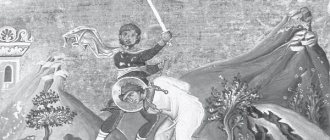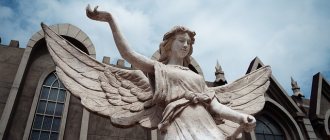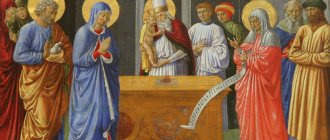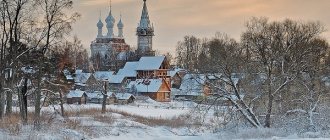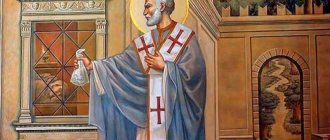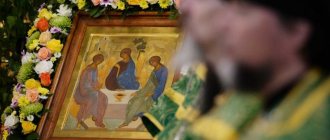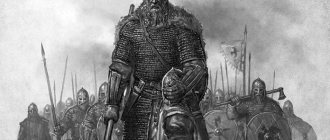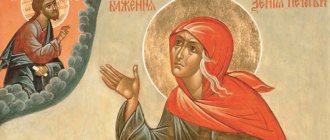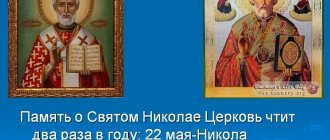Saint Tryphon - patron saint of hunters and fishermen
The holy martyr Tryphon was born in one of the regions of Asia Minor - Phrygia, not far from the city of Apamea, in the village of Kampsada. His parents were simple peasants. As a child, he tended geese and did not receive an education, but as a child he cast out demons, healed illnesses and did many good deeds with his prayer. One day, by the power of his prayer, Tryphon forced away the harmful insects that were destroying the crops, and thereby saved the inhabitants of his native village from hunger. The saint became especially famous for casting out a demon from the daughter of the Roman Emperor Gordian. A demon possessed the young princess and tormented her severely. One day he shouted that only Tryphon could drive him out. The emperor ordered to find the miracle worker and bring him to Rome. Then Tryphon was 16 years old. When the saint approached Rome at a distance of three days' journey, the evil spirit could not bear his approach and left the daughter of Gordian.
When Emperor Decius, a cruel persecutor of Christians, ascended the royal throne, his eparch Aquilina was informed that Saint Tryphon was boldly preaching Christianity. Hearing that the royal servants were looking for him, Saint Tryphon did not hide and gave himself into the hands of the persecutors. Brought to trial before Aquilina, he boldly confessed his faith. Then the eparch ordered to tie the hands of the holy martyr, hang him on a tree and beat him for three hours. After this, Saint Tryphon was thrown into prison. After some time, Aquilinus once again used threats and persuasion, and then, seeing the futility of his efforts, subjected the martyr to new tortures.
When the martyr was forced to follow the horse on which the eparch went hunting, Saint Tryphon sang verses from the psalms of the prophet David. During the torment, an angel appeared before the saint with a precious crown in his hands. Seeing this, the tormentors were frightened, but Aquilinus became even more embittered. The next day he continued the torture, after which he sentenced the martyr Tryphon to be beheaded by the sword. Before his death, the saint thanked God, who strengthened him in his suffering. Christians wanted to bury the body of the martyr in the city of Nika, but Saint Tryphon ordered his body to be transferred to his homeland, to the village of Kampsada. Subsequently, the relics of Saint Tryphon were transferred to Constantinople, and then to Rome.
There is also a legend that during the reign of Tsar Ivan the Terrible, the king’s favorite gyrfalcon flew away during a hunt. The Tsar ordered falconer Trifon Patrikeev to find the flown away bird and threatened him with death for failure to comply with the order. Sokolnik traveled around the surrounding forests, but to no avail. On the third day, he stopped on an island in the middle of a large pond in Maryina Roshcha and, tired of a long search, lay down to rest, diligently asking for help from his patron, the holy martyr Tryphon. In a dream, he saw a young man on a white horse, holding the royal gyrfalcon in his hand. This young man said: “Take the missing bird, go with God to the king and don’t be sad about anything.” Waking up, the falconer saw the gyrfalcon he was looking for nearby on a pine tree. He immediately took him to the king and told him about the miraculous help he received from the holy martyr Tryphon. Soon, on the spot where the saint appeared, the falconer Tryphon Patrikeev built a chapel, and then a church in the name of the holy martyr Tryphon.
It’s not for nothing that we cited the geography of the legend in such detail. The fact is that in Moscow the Church of St. Tryphon in the very place where, according to legend, the falconer
miraculously found a falcon. The grove itself has long been gone, in its place there is now a district of the same name, and there are no ponds that gave the name to the village that arose near the church - Naprudny. At the beginning of the 20th century. The ponds became very shallow and turned into swamps, so in the 40s they were filled in, and then residential areas grew in their place. On the site of the village stands the huge building of the Moscow Regional Research Clinical Institute, better known as the “MONIKI Hospital”. And the church itself, small in modern times, accommodating less than 100 people, dating back to 1492 (the year of the discovery of America, for comparison), was precisely lost against the background of this medical colossus. She got lost, but survived and even opened up to parishioners a few years ago. An elegant white stone building with a minimum of details kept a miraculous icon with a piece of the relics of St. for many centuries. Tryphon and the secret of his birth. Only in the 20s of the last century, restorers discovered ancient Russian graffiti (scratched inscription on stone) on its walls, which they managed to date back to 1492. Several more graffiti are still visible to the naked eye today on the south side of the church. You can even touch it with your hand. And when entering the church, be sure to raise your head up - you will see a cross under the dome. It seems like an unnecessary reminder, and it’s already clear to everyone that the cross is a Christian symbol. However, such domed crosses in ancient churches are reminiscent of the times of the struggle against the heresy of the Judaizers, a sect that denied the cross.
The memory of the saint remains in the Moscow topography - Trifonovskaya Street is located next to the church. It goes along the bottom of the former pond, so the church and MONIKI appear to be on a hill - a former island.
Saint Tryphon was revered in Muscovite Rus' as a healer, patron of hunters and ruler of reptiles. The Orthodox Church is wary of spells and other similar forms of folk culture, but the “Spell of St. Tryphon against Reptiles” is considered canonical. Read the beginning of this amazing text: “I conjure you, many-species animals, worms, caterpillars, beetles and pruses, mice, sciatica and crits, and various kinds of flies and midges, and moths, and moths, and gadflies, and wasps, and millipedes and various kinds of animals crawling on the ground, and flying birds, causing harm and vanity to fields, grapes, orchards and heliports...” In general, the Colorado potato beetle covers itself with fear and flies back to Colorado.
By the way, girls and barren women turn to Saint Tryphon with a request to send a good groom, so our saint is also noticed in the field of love and marriage relationships. And in comparison with the frivolous interpretation of Valentine's Day indiscriminately, Tryphon, it turns out, stands for traditional relationships.
Russian saint - St. Trifon Pechenga
Venerable Tryphon of Pechenga is a Russian monk who founded the northernmost monastery in Russia and Europe. By the feat of his life he proved that with God’s help nothing is impossible for a believer. The harsh climate, numerous difficulties, and the opposition of others are not able to shake an ascetic faithful to the true Path, who has made his goal the enlightenment of people and the glorification of the Creator.
St. Trifon Pechenga
In June 1495, within the Novgorod region, a boy was born into the pious family of a priest, who received the name Mitrofan at baptism. Since childhood, he loved church services and tried to be one of the first to attend them. One day during a service, his heart was struck by the words:
“The deserted belly is blessed to eat, revived by Divine zeal,” - from that moment on, the young lad often went to secluded places, a field or forest, and there he remained in quiet prayer alone with the Lord.
On one of these days, Mitrofan heard the voice of the Savior, commanding him to leave his father’s house and go “to the deserted, thirsty lands.” Mitrofan did not immediately understand what these places were, but God opened his spiritual vision and the young man realized that he needed to go to unenlightened peoples who did not know the Word of God.
Obedient to the Will of God, guided by the Holy Spirit, Mitrofan set off to foreign lands. The spirit led him to the Arctic Ocean, to the Kola region, where the Pechenga River flowed. The indigenous inhabitants of these places were the Lapps - a people living in the grossest ignorance.
The Lapps worshiped stones and cliffs, rivers, lakes, mountains, venerated wild animals and sea animals, and made rich sacrifices to them. The villages were spread along the shore of the Pechenga almost a hundred miles from each other.
Mitrofan walked along the shore and, little by little, with God's help, made acquaintance with the local residents. At first, he took on the appearance of a merchant and talked only about buying goods, but soon he began to communicate more with the Lapps and talk about the local religion.
Gradually, he began to draw their attention to the inconsistency of the local gods, their emptiness and falsity, at the same time telling them about the true God, the Creator of heaven and earth. He also told about the Savior who came to earth to suffer for sinners.
With his sermons, Mitrofan provoked a fierce confrontation between the local wise men and sorcerers. The pagan priests tried with all their might to harm him, demanding that he leave these places. They threw stones at the poor man, beat him with stakes, and threatened to put him to a brutal death. But the Lord invisibly guarded his saint, hiding him in rocky crevices, and sometimes even invisibly led him past his enemies.
Mitrofan preached among the Lapps for many years. With God's help, the people gradually began to become enlightened, and a Christian community was formed. A wooden church was built on the banks of the Pechenga. The only thing missing was an ordained priest to baptize the converts.
Mitrofan fervently prayed to the Lord about this difficulty, and one day he met the monk Elijah in those places, returning from the Finns, where the Novgorod Archimandrite Macarius had sent him to preach. Elijah consecrated the built church and performed the rite of baptism, and elevated Mitrofan to the rank of monk, tonsuring him into monasticism and giving him the name Tryphon.
After some time, the church was overgrown with buildings, a small monastery was formed, where monks and pilgrims came from all over the Russian land. Gradually the monastery expanded, and Mitrofan’s disciple Gury became its abbot. However, the conditions of the Russian north were difficult: harsh winters and rocky land unsuitable for agriculture did not give the monks the opportunity to make sufficient food supplies.
The brothers were threatened with famine. Then the monk went to Novgorod and other large cities to collect alms for his spiritual children. His wanderings lasted 8 years. During this time, rumors spread about the righteous man as a miraculous healer who could cure the most serious illnesses.
During his wanderings, the venerable royal city of Moscow visited. A miracle happened here, which further glorified the Pechenga monastery.
One morning, Tsar John Vasilyevich with the young Tsarevich Theodore and the boyars went to the Liturgy. On the way, he met two unfamiliar monks. The Emperor wanted to know who these strangers were. It turned out that one of them came from the Solovetsky Monastery, and the other was the humble monk Tryphon from the Pechenga monastery. When the king wanted to talk with them, the monks became invisible to others, which surprised everyone a lot.
The next morning the monks met the king again. This time they submitted petitions to him. After the service, John ordered the elders to be brought to him, and then it turned out that the “monks” had just arrived in the city and had not yet had time to submit their petitions to the king. The royal surprise was great; he realized that great saints of God were standing before him.
Since then, the Solovetsky Monastery and the Pechenga Monastery began to enjoy special royal favor. John donated bells and church utensils to the Pechenga monastery, and Tsarevich Theodore donated precious clothes so that they could be converted into festive clothes for priests.
What is the date of the saint’s memory?
28
December
1583
Having lived 88 years, Tryphon of Pechenga died blissfully, commanding the brethren to bury him in the desert near the Church of the Assumption of the Blessed Virgin Mary.
The day of the saint’s Assumption became the day of his remembrance: December 28
But even after the death of the elder, miracles associated with his name did not stop happening.
Soon after the death of the saint, during the Russian-Swedish war of 1590-1595, Tsar Theodore Ioannovich besieged one of the enemy cities. The Swedes secretly sent spies into the Russian camp to find out in which tent the king was spending the night, intending to destroy the tent with cannonballs.
That same night, the venerable elder appeared to Tsar Theodore in a dream and warned him of the impending assassination attempt. The king left the dangerous place in time: soon enemy cannonballs fell on his tent, one of which pierced the bed on which he was supposed to sleep. The grateful ruler immediately sent rich gifts to the Pechenga monastery, and was greatly saddened to learn that the Monk Tryphon was no longer alive.
In those same years, Swedish soldiers and the Finnish gangs that helped them besieged the sacred monastery and on the very day of Christmas, by God's permission, took the monastery by storm. The Great Holiday was desecrated by a brutal murder: 116 monks and laymen who were present at the service became victims of cruel robbers.
Before his death, Lord Guria was tortured for a long time, trying to find out where the treasures donated to the monastery were kept. Having learned nothing from the abbot, the wicked burned the holy monastery with the relics of Saint Tryphon resting in the Church of the Dormition of the Theotokos.
Of course, such an atrocity could not go without retribution. On the way back, the blood-drunk robbers got lost in the coastal rocks and died of severe starvation, in vain calling on Heaven for the salvation of their souls. The news of the terrible tragedy reached Tsar Theodore. Greatly saddened, he ordered the monastery to be built anew.
Patron of travelers, sailors and fishermen
The Monk Tryphon had to spend a good part of his life in wanderings. Only thanks to fervent prayer and God's help, the saint miraculously remained alive, preserved from wild animals and pagans. And now travelers often turn to the holy saint for help.
St. Trifon Pechenga
The saint is revered as the patron saint of sailors and everyone related to maritime affairs. The basis for this was the case of the miraculous deliverance of a boat that was once sent from the monastery to go fishing. A boat caught in a storm was carried into the abyss. In desperation, the fishermen prayed to the Holy Trinity and the patron saint of those places, Saint Tryphon of Pechenga, asking to save their lives.
Suddenly a handsome old man appeared before them, walking on the waves, his face similar to the Monk Tryphon. The elder made the sign of the cross over the boat and ordered the storm to calm down. The fishermen's lives were saved.
A similar incident occurred with boats sailing with grain supplies along the Dvina. At one of them was the monk of the Pechenga monastery Arkady. A sudden storm that arose threatened to sink the boats, then Arkady prayed to Saint Tryphon of Pechenga, asking him to help the unfortunate. At that moment, a pious old man was seen on the ship, helping to level the bow with ropes. This boat was the only one that survived the storm; the rest were sunk by the raging elements.
A skilled healer who heals diseases
During his lifetime, the monk was known as a skilled healer who alleviated human suffering. The saint called on people tormented by illnesses to repent and begin to live works of mercy. Today, like five centuries ago, pilgrims from different countries come to his grave, asking for relief from diseases.
Through prayers to the saint, paralysis, deafness, blindness, bleeding, headaches and other diseases are healed. The monk appeared to some of the healed in a dream vision, blessing and touching the sore areas with his finger, after which the sufferers fully recovered.
And to a resident of Kola, fisherman Illarion Grokhotov, who once severely injured his eye while fishing and on the way to the hospital fervently begged the saint not to abandon his intercession, the holy monk appeared in the form of a radiant old man, who touched the sufferer with the edge of his robe, after which the eye was completely healed.
ICON
St. Trifon Pechenga
On icons, Saint Tryphon of Pechenga is most often depicted as an old man holding in his hands a scroll with his most famous teachings. The image can be half-length or full-length. Often, next to the monk, the place of his asceticism is depicted - the Pechenga River and the monastery of the Life-Giving Trinity that he founded.
From Rome to Moscow
According to legend, the fame of Tryphon’s gift spread throughout the earth. She also reached the palace of Emperor Gordian III, where his young daughter was suffering from seizures. The emperor sent for the boy. As soon as he approached Rome, there were only three days left to reach the city, when the devil jumped out of the girl’s body. Such was his strength. When Tryphon found himself in the palace, he forced the devil to show himself to all the courtiers and promise that he would leave and never return. The devil did not look the best - like a mad dog with burning eyes and his muzzle pressed to the floor. However, Tryphon did not receive any benefits from the treatment of the imperial daughter. The power in Rome then changed like the weather. A few years later, under Decius Trajan, he was executed, like other Christians. Initially, Tryphon was not considered the patron saint of hunters; he healed women from infertility. Also helped fight infestations of caterpillars, flies and other pests. Gradually he began to be considered the ruler of all forest inhabitants. But the full image of Tryphon as the patron of hunting and hunters took shape during the reign of Ivan the Third, when rumors of a miracle with the gyrfalcon spread. Here, however, the legends differ. Initially, the gyrfalcon, lost during a hunt by Prince Ivan Yuryevich Patrikeev, was found by him after prayer exactly on the day of St. Tryphon, that is, on the first of February. Gradually, the legend acquired additions, and the falconer Trifon Patrikeev appeared in it, and Ivan the Third, who bore the nickname Grozny, turned into Ivan the Terrible. However, the gyrfalcon, it seems, was miraculously found, because in memory of this miracle, Ivan the Third ordered a church dedicated to St. Tryphon to be built at the site where the bird was found. It was built in 1470-1490. Since that time, the falcon even appeared on the coat of arms of Moscow, first on the hand of Saint Tryphon, then Tryphon was replaced by St. George the Victorious. And Tryphon became the legalized patron of Moscow hunters.
People and animals
The priests themselves could not carry weapons and shed the blood of others. Many saints shielded with their bodies not only their persecuted brothers, but also “dumb creatures.” So at first the hunters did not have heavenly patrons. The fishermen were luckier in this regard: they had several heavenly helpers - Nikolai, who not only saved drowning people, but could, on occasion, drive a school of fish into the net; the apostles Andrew, John, Peter and James, who were engaged in fishing and also caught human souls; and even Thomas the Unfaithful. Hunting, of course, has not disappeared from the life of society at that time. On the contrary, in the feudal world it became a privileged occupation. It was considered a complete dishonor for a medieval feudal lord if he could not organize a hunt for his overlord. The overlord did not arrive at the castle of his vassal along with his retinue in order to attend the feast arranged for him. No, he was looking forward to the most fun entertainment in the world - hunting with a pack of dogs for deer, elk, wild boar and other animals. So gradually the attitude towards hunting changed. And, of course, hunting and hunters now have a heavenly protector. But by that time the paths of Eastern and Western Christianity had already diverged. And there were two patrons.
